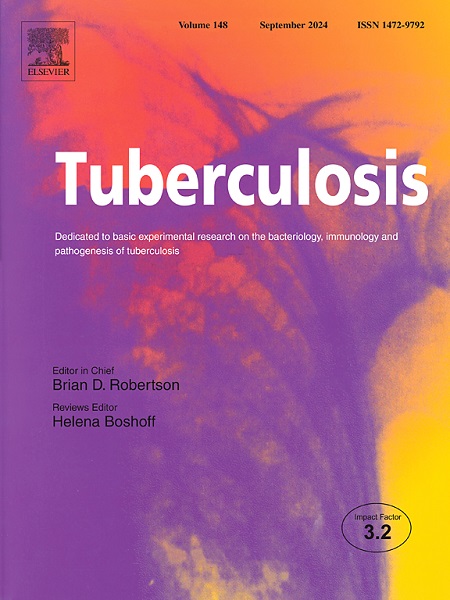诊断青少年肺结核的生物标志物:外周血单核细胞肌小管蛋白相关蛋白4和抑癌素M基因
IF 2.9
3区 医学
Q3 IMMUNOLOGY
引用次数: 0
摘要
背景/目的尽管研究越来越多地关注青少年肺结核(PTB),但其诊断仍然复杂且具有挑战性。因此,本研究评估了宿主转录标记在青少年肺结核诊断中的应用。方法选取2013年1月至12月在安徽省胸科医院首次确诊的PTB青少年(14-18岁)40例(病例组)和同期在中国科学技术大学第一附属医院体检的健康青少年(对照组)32例。采集两组患者外周血样本,对分离的单核细胞进行转录组测序和生物信息学分析。通过定量聚合酶链反应确定相关基因。利用受试者工作特征曲线分析这些基因在青少年肺结核患者中的诊断价值。此外,通过H37Ra结核分枝杆菌感染THP-1细胞构建体外模型,评估鉴定的基因在体外表达水平是否与青少年PTB外周血单核细胞中的基因表达水平一致。通过慢病毒感染、流式细胞术、免疫荧光、Western blotting和qRT-PCR等方法探讨了其具体机制。结果病例组肌小管蛋白相关蛋白4基因(MTMR4)表达水平低于对照组(P <;0.0001;曲线下面积:0.946;95%置信区间:0.893-0.999;截断值:0.844;灵敏度:0.875;特异性:0.969)。病例组肿瘤抑制素M基因(OSM)表达水平高于对照组(P = 0.014;曲线下面积:0.962;95%置信区间:0.914-1.000;截止值:0.919;灵敏度:0.950;特异性:0.969)。而补体成分1q亚成分A基因的表达水平在组间无显著差异。体外实验结果表明,在h37ra感染细胞和病例组样本中,MTMR4和OSM的表达水平一致。生物信息学分析显示,细胞因子-细胞因子受体相互作用、JAK/STAT信号通路和PI3K/细胞存活相关通路在青少年PTB发病过程中发挥关键作用。此外,我们发现H37Ra感染通过OSM/PI3K/GPX4途径影响结核病的进展。结论外周血单核细胞OSM和MTMR4可能是青少年肺结核的生物标志物。我们推测,通过降低OSM表达或抑制其配体/受体来靶向OSM信号通路可能是减少肺结核相关组织损伤的一种策略。本文章由计算机程序翻译,如有差异,请以英文原文为准。
Biomarkers for diagnosing pulmonary tuberculosis in adolescents: Peripheral blood monocyte myotubularin-related protein 4 and oncostatin M genes
Background/objectives
Although research has increasingly been focused on pulmonary tuberculosis (PTB) in adolescents, its diagnosis remains complex and challenging. Thus, the use of host transcription markers in the diagnosis of adolescent PTB was evaluated in this study.
Methods
The study cohort comprised 40 adolescents (aged 14–18 years) with PTB who had received their first PTB diagnosis at Anhui Provincial Chest Hospital, China, between January and December 2023 (case group) and 32 healthy adolescents who had undergone physical examinations at The First Affiliated Hospital of the University of Science and Technology of China during the same period (control group). Peripheral blood samples were collected from both groups, and isolated monocytes were subjected to transcriptome sequencing and bioinformatic analysis. The relevant genes were confirmed through quantitative polymerase chain reaction. The diagnostic value of these genes in adolescent PTB patients was analysed using receiver operating characteristic curves. Furthermore, an in vitro model was constructed by infecting THP-1 cells with the Mycobacterium tuberculosis strain H37Ra to assess whether the in vitro expression levels of the identified genes were consistent with those of the genes in the peripheral blood monocytes of adolescents with PTB. The specific mechanisms were explored using methods such as lentiviral infection, flow cytometry, immunofluorescence, Western blotting, and qRT‒PCR.
Results
The results revealed that the expression level of the myotubularin-related protein 4 gene (MTMR4) was lower in the case group than in the control group (P < 0.0001; area under the curve: 0.946; 95 % confidence interval: 0.893–0.999; cut-off value: 0.844; sensitivity: 0.875; specificity: 0.969). The expression level of the oncostatin M gene (OSM) was greater in the case group than in the control group (P = 0.014; area under the curve: 0.962; 95 % confidence interval: 0.914–1.000; cut-off value: 0.919; sensitivity: 0.950; specificity: 0.969). However, no significant between-group difference was detected in the expression level of the complement component 1q subcomponent A gene. The results from the in vitro experiment indicated that the expression levels of MTMR4 and OSM were consistent between the H37Ra-infected cells and the case group samples. Bioinformatics analysis revealed that cytokine–cytokine receptor interactions, JAK/STAT signalling and PI3K/cell survival-related pathways play key roles in the pathogenesis of adolescent PTB. Additionally, we found that H37Ra infection affected tuberculosis progression via the OSM/PI3K/GPX4 pathway.
Conclusions
Peripheral blood monocyte OSM and MTMR4 may serve as biomarkers of adolescent PTB. We speculate that targeting the OSM signalling pathway by knocking down OSM expression or inhibiting its ligand/receptor might be a strategy to reduce pulmonary tuberculosis-related tissue damage.
求助全文
通过发布文献求助,成功后即可免费获取论文全文。
去求助
来源期刊

Tuberculosis
医学-呼吸系统
CiteScore
4.60
自引率
3.10%
发文量
87
审稿时长
49 days
期刊介绍:
Tuberculosis is a speciality journal focusing on basic experimental research on tuberculosis, notably on bacteriological, immunological and pathogenesis aspects of the disease. The journal publishes original research and reviews on the host response and immunology of tuberculosis and the molecular biology, genetics and physiology of the organism, however discourages submissions with a meta-analytical focus (for example, articles based on searches of published articles in public electronic databases, especially where there is lack of evidence of the personal involvement of authors in the generation of such material). We do not publish Clinical Case-Studies.
Areas on which submissions are welcomed include:
-Clinical TrialsDiagnostics-
Antimicrobial resistance-
Immunology-
Leprosy-
Microbiology, including microbial physiology-
Molecular epidemiology-
Non-tuberculous Mycobacteria-
Pathogenesis-
Pathology-
Vaccine development.
This Journal does not accept case-reports.
The resurgence of interest in tuberculosis has accelerated the pace of relevant research and Tuberculosis has grown with it, as the only journal dedicated to experimental biomedical research in tuberculosis.
 求助内容:
求助内容: 应助结果提醒方式:
应助结果提醒方式:


